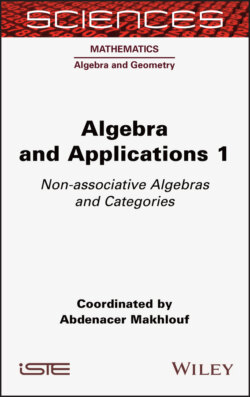Читать книгу Algebra and Applications 1 - Abdenacer Makhlouf - Страница 15
1.5. Cheng–Kac superalgebras
ОглавлениеGiven an arbitrary unital associative commutative (super)-algebra with an (even) derivation d : Z → Z, Martínez and Zelmanov constructed (Martínez and Zelmanov 2010) a Jordan superalgebra JCK(Z, d) named the Cheng–Kac Jordan superalgebra.
The even part of JCK(Z, d) is a rank 4 free module over Z with basis {1, w1, w2, w3}, , and multiplication given by wiwj = 0 if 1 ≤ i ≠ j ≤ 3, . The odd part of this superalgebra is also a rank 4 free module over Z with basis {x, x1, x2, x3}, .
The action of the even part on the odd part and the products of two elements, respectively, are given by the following multiplication tables:
where xi × i = 0, x1 × 2 = –x2 × 1 = x3, x1 × 3 = –x3 × 1 = x2, –x2 × 3 = x1 = x3 × 2.
The superalgebra JCK(Z, d) is simple if and only if Z is d-simple, that is, Z does not contain proper d-invariant ideals (see Martínez and Zelmanov (2010)).
Let us remark that for Z = ℂ[t, t–1] the above construction leads to the Cheng–Kac superconformal algebra, that is, CK(6) = TKK(JCK(6)), where
with (see section 1.8).
